Complete Solutions to Problem for self practice of chapter ELECTRICAL INSTRUMENTS of Class 12 book with complete answers and questions
| Class 12 | PHYSICS |
| Chapter | ELECTRICAL INSTRUMENTS |
| SL ARORA | Problem for self practice |
| Number Of Questions | 81 |
| Academic Year | 2023-24 |
A cell of emf 2 V and internal resistance `1Omega` has its terminals joined by resistanecs of 5 and `10Omega` in paralle. Using kirchhoff's laws, find the current through the cell and the current drawn through each resistance.
View SolutionShown n batteries connected to form a circuit. The resistances donote the internal resistances of the batteries which are related to the emf's as `r_(i)=k(epsilon)_(i)`where K is a constant. The solid dits represent the terminals of the batteries. Find (a)the current through the circuit and (b) the potential difference between the terminals of the ith battery.

View SolutionTwo cells of emfs 1.5 V and 2.0V internall resistance `1 Omega` and `2 Omega` are connected in parallel so as to send current in the same direction through an external resistance of `5 Omega`.
(i) Draw the circuit diagram. (ii) Using Kirchhoff's rules, calculate.
(a) current through each branch of the circuit (b) potential difference across the `5 Omega` resistance.
View Solution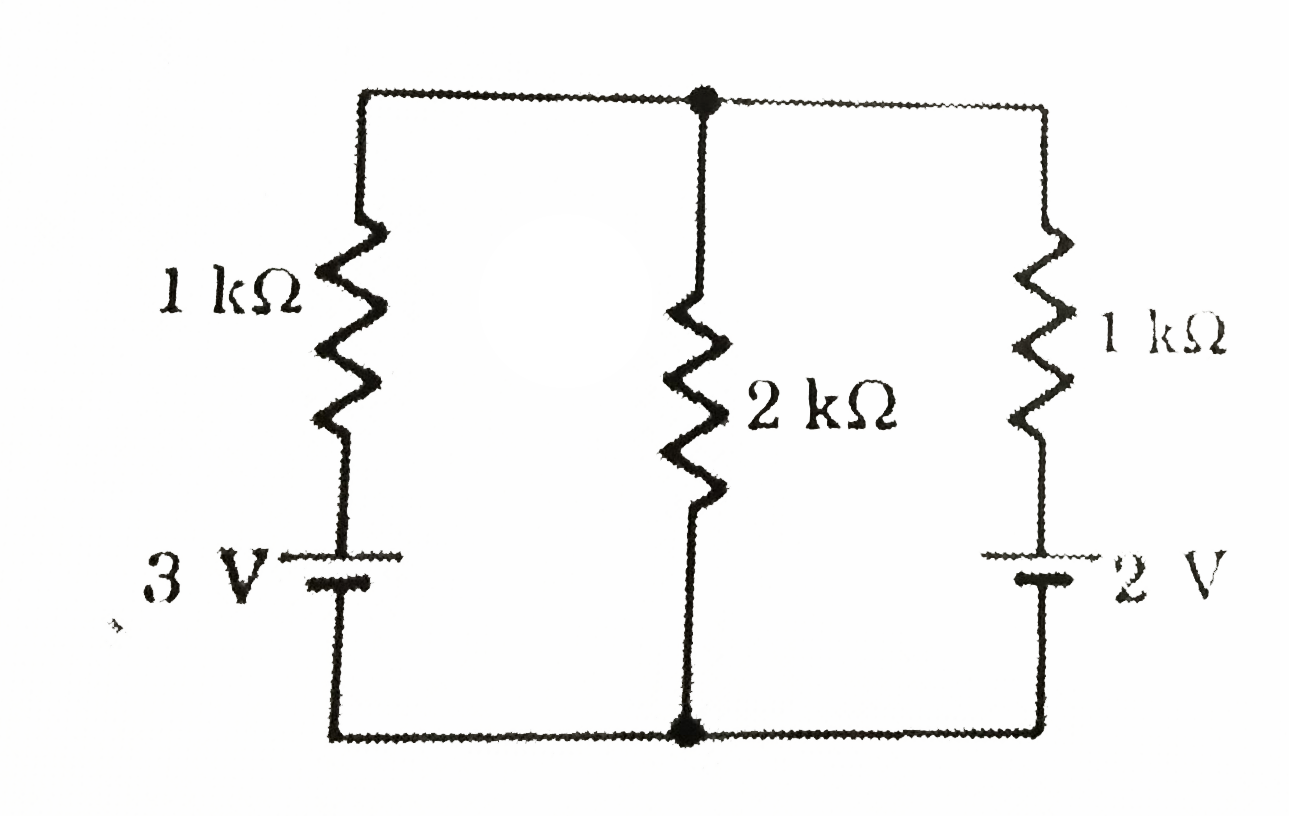
Calculate the potential difference across the 2k `Omega` resistor in the circuit shown in figure. The internal resistance of the cells are negligible.
View Solution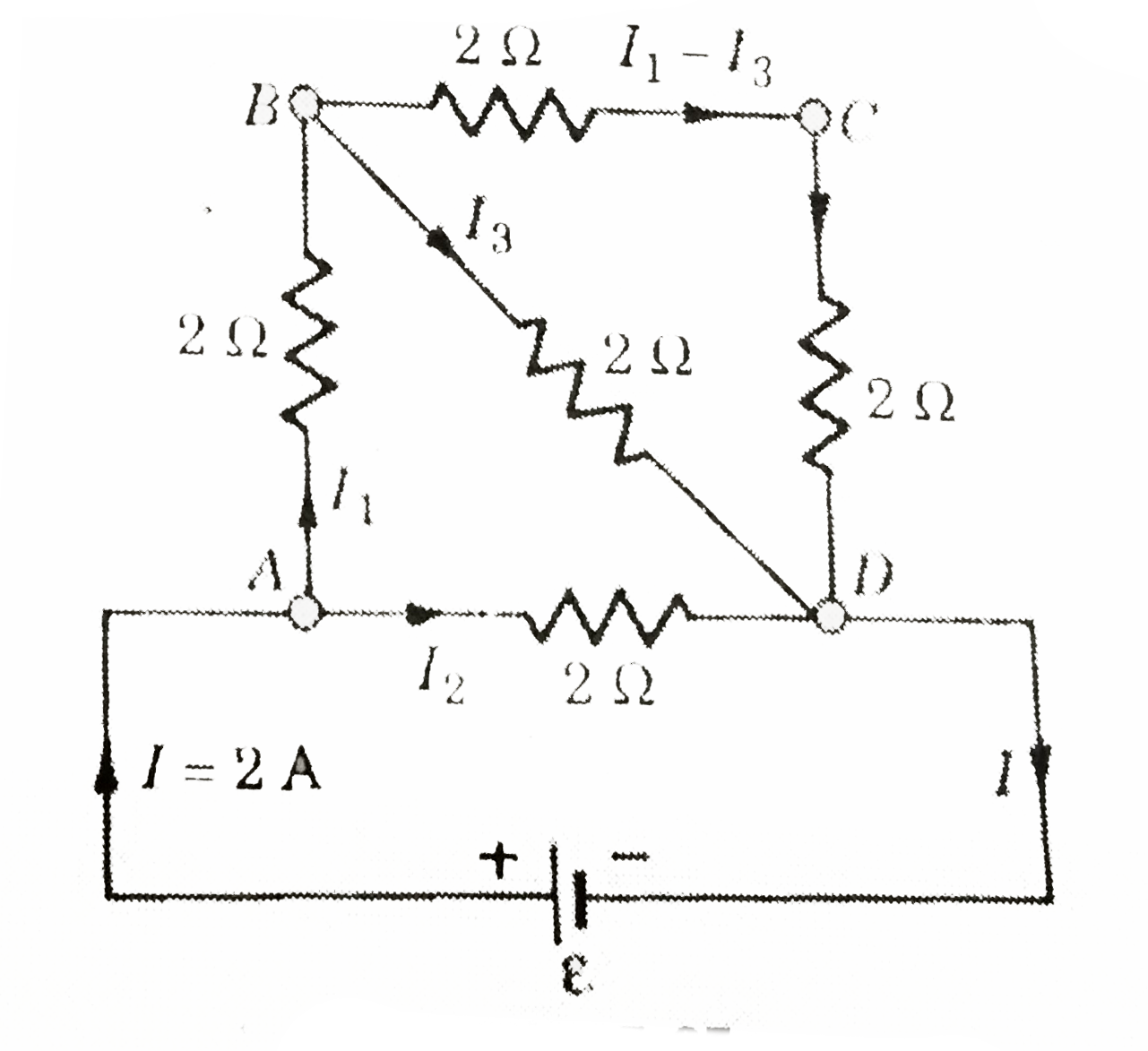
A network of resistors is connected to a battery of negligible internal resistance, as shown in figure. Calculate the equivalent resistance between the point A and D, and the value of the current `I_(3)`.
View Solution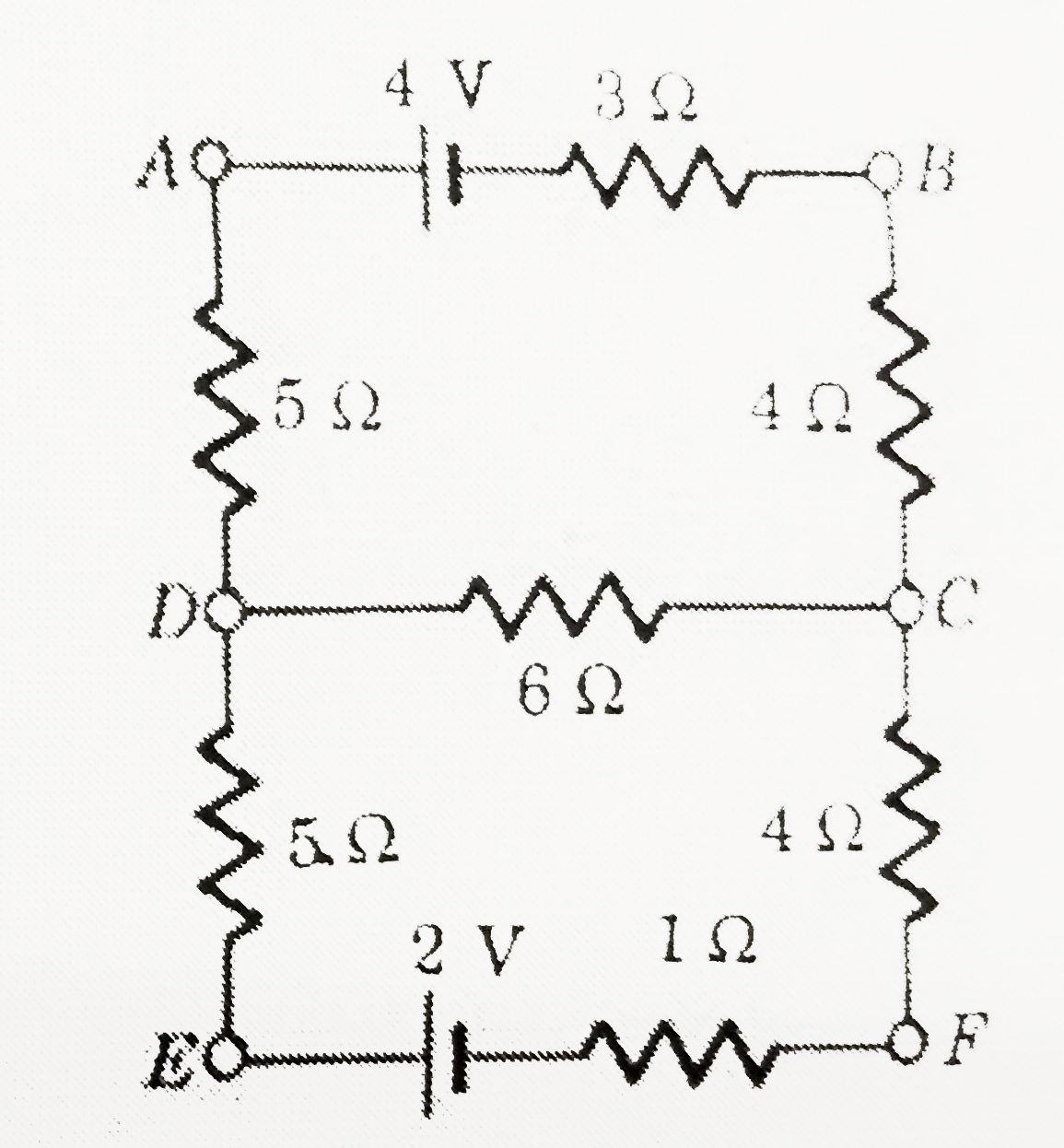
Calculate (i) current in the `6Omega` resistor, (ii) terminal voltage across the 4V cell in the circuit shown in figure.
View SolutionThree cells are connected in parallel with their like poles connected together with wires of negligible resistance. If the emfs of the cells are 2, 1 an 4 V respectively and their internal resistances are 4,3 and `2Omega` respectively, find the current through each cell.
View Solution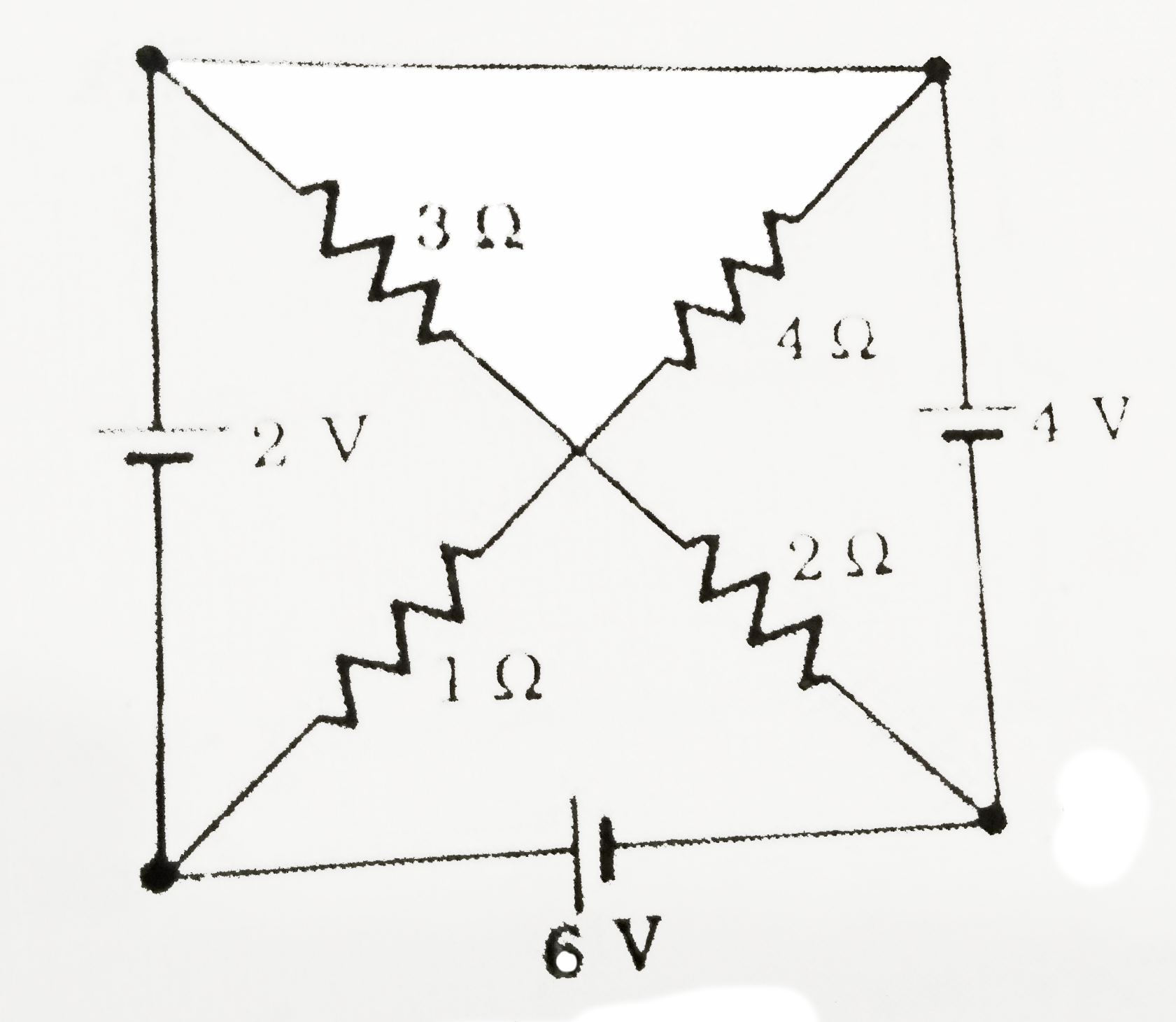
In the network shown in figure. (i) calculate the current of the 6V battery and (ii) determine the potential difference between the points A and B.
View Solution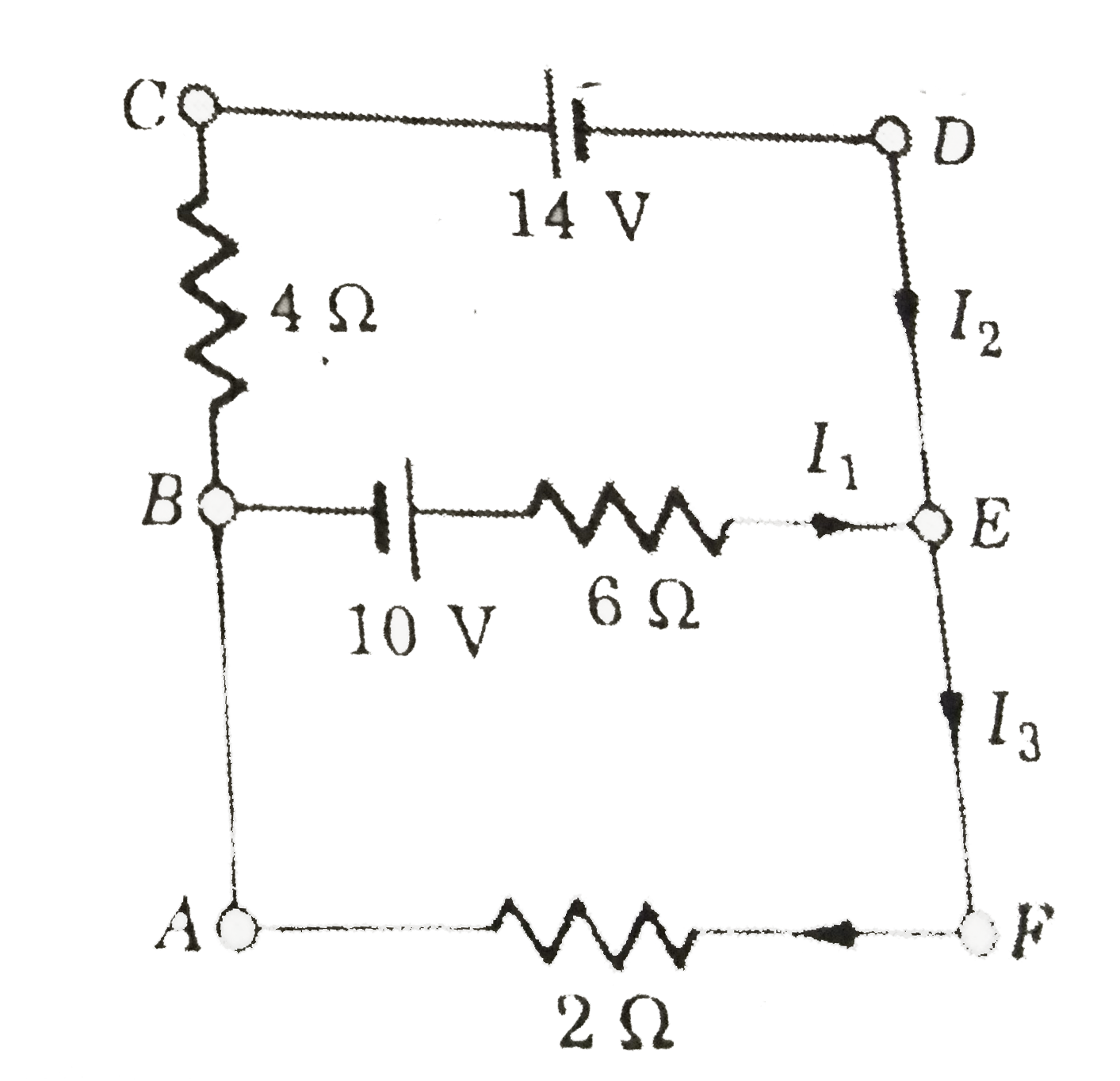
In the network shown in figure. Find (i) the currents `I_(1),I_(2) and I_(3)` and (ii) the potential difference between the points B and F.
View Solution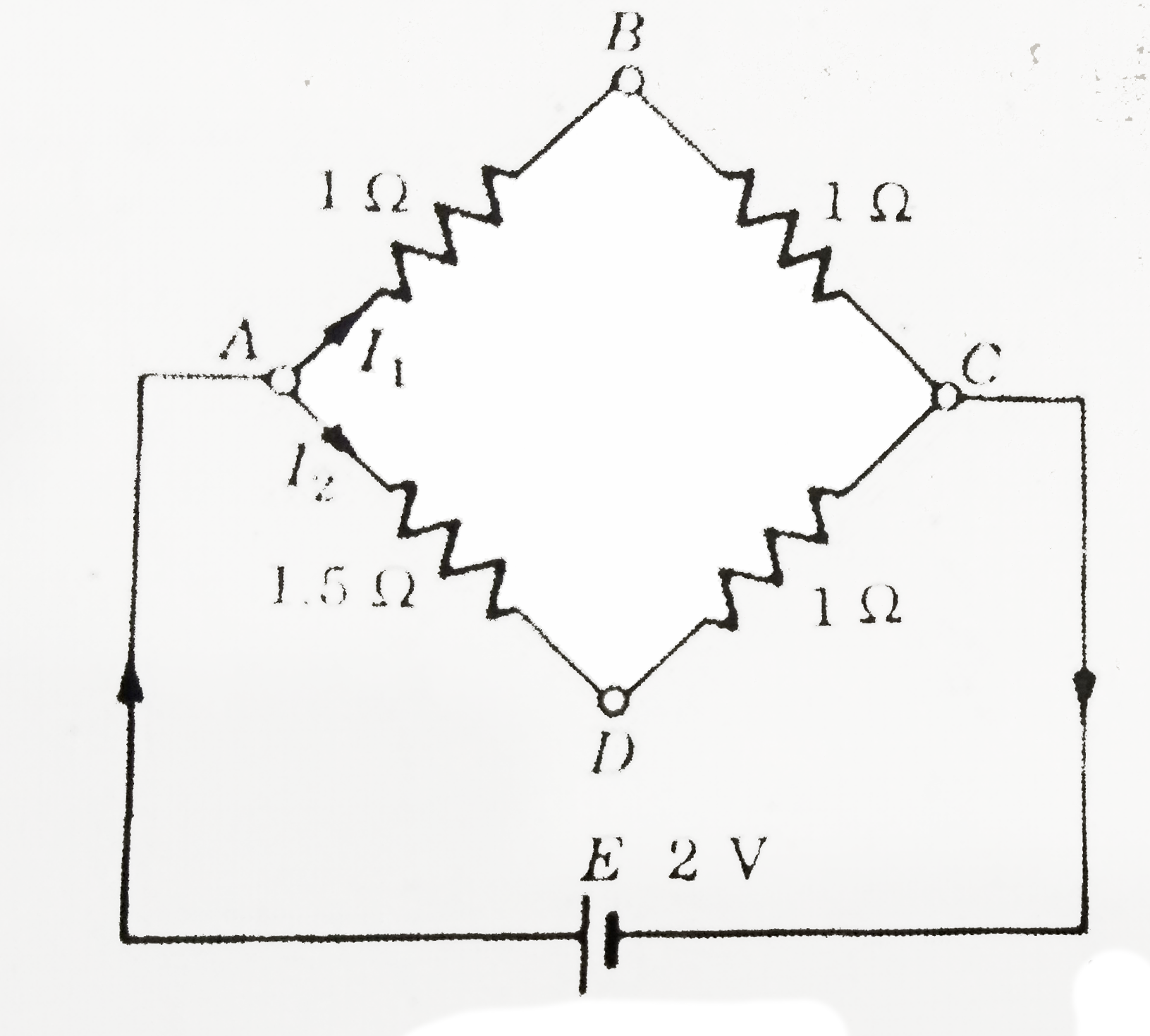
Calculate the potential difference between the junctions B and D in the wheatstone's bridge shown in figure.
View SolutionFor the network shown in the figure, the value of the current `i` is
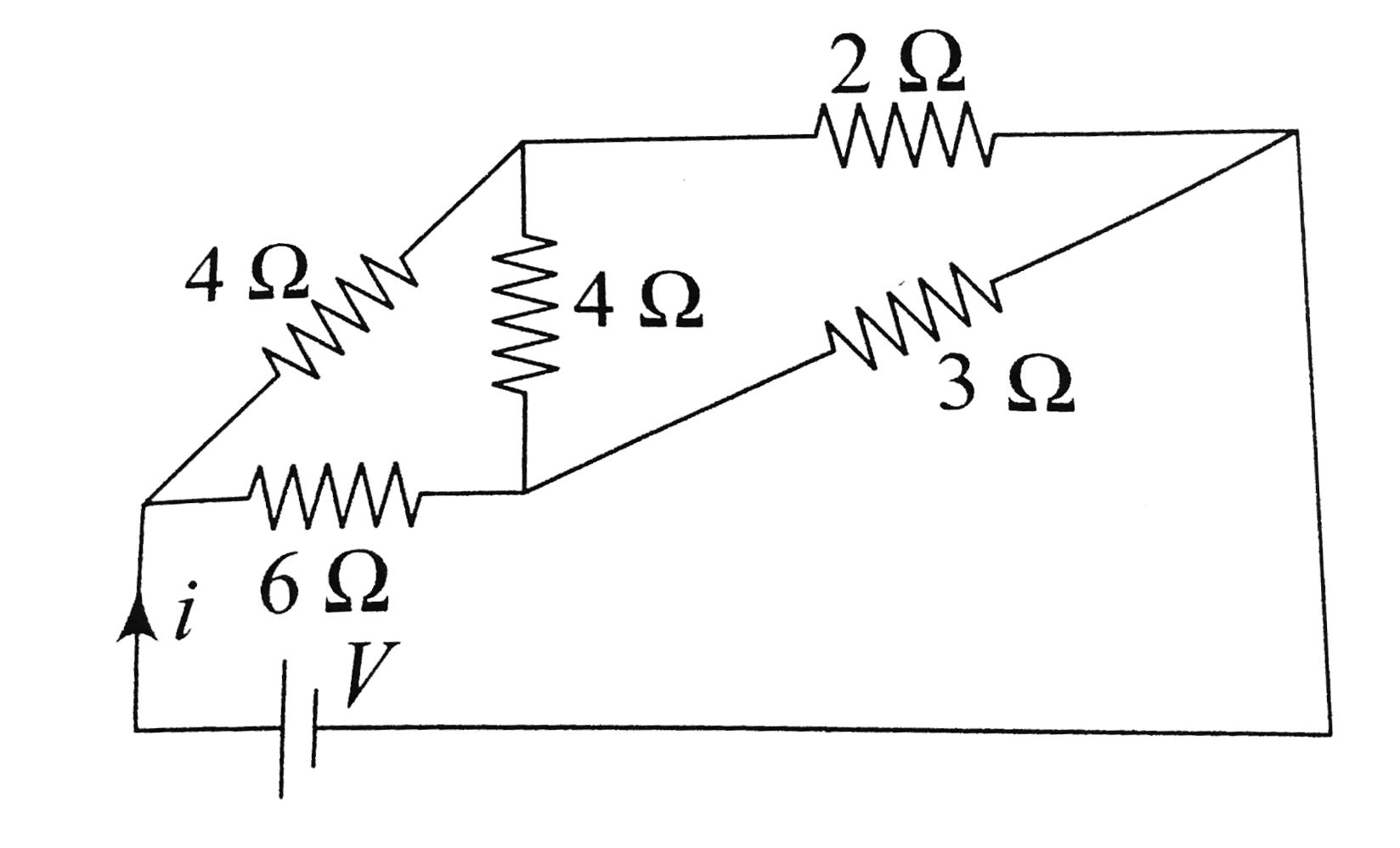
View Solution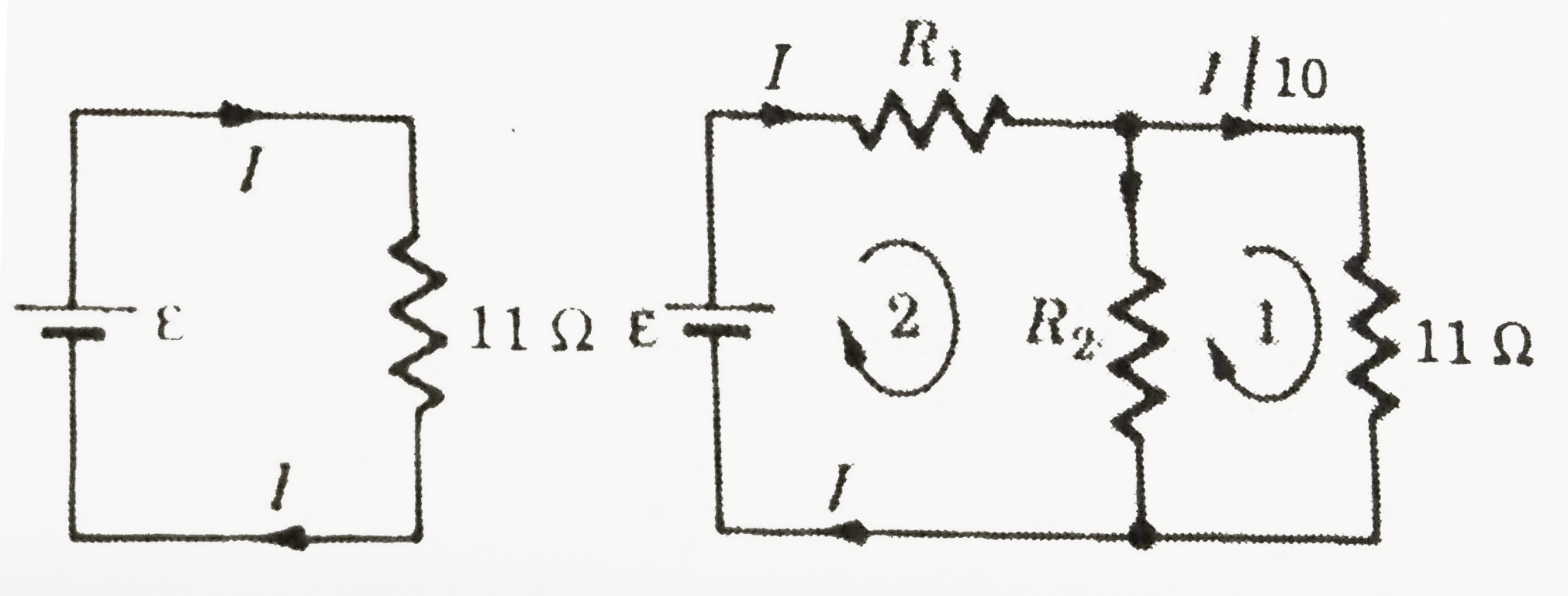
What does the ammeter A read in the circuit shown in figure? What if the positions of the cell and the ammeter are interchanged?
View Solution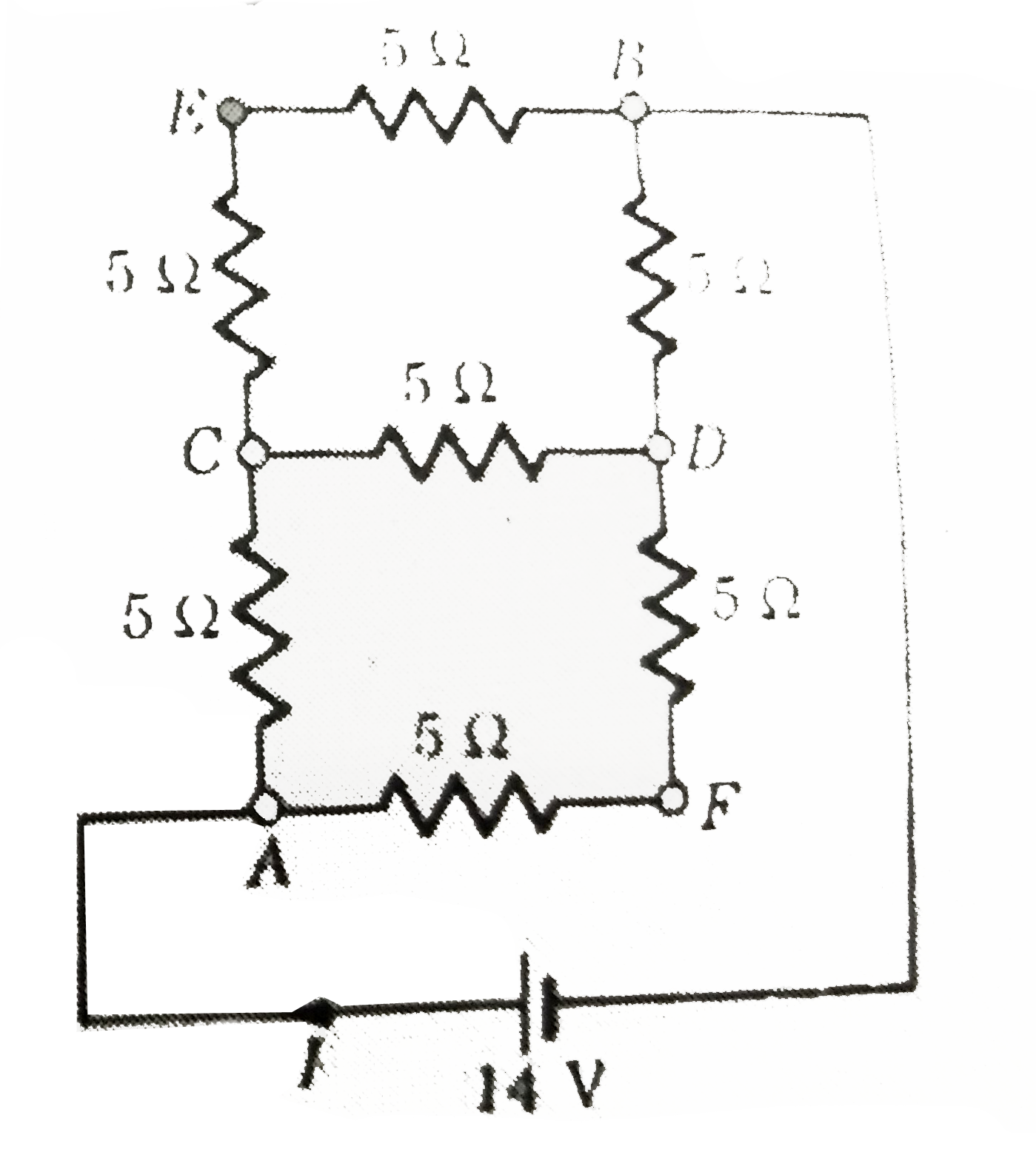
In the circuit shown in figure. Determine the current in the resistance CD and equivalent resistance between the points A and B. the iternal resistance of the cell is negligible.
View Solution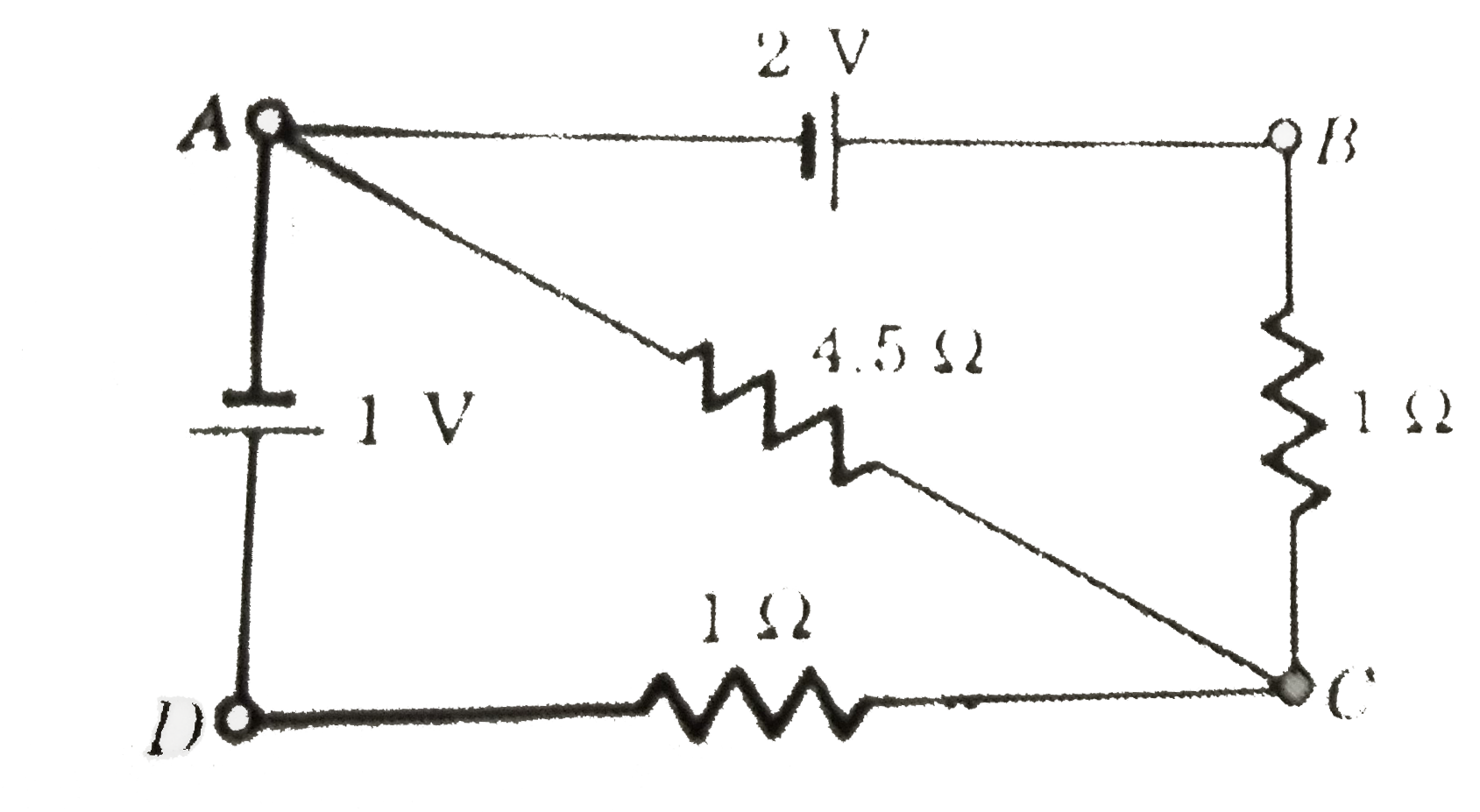
calculate the current flowing in each of the resistances of the network shown in figure. The internal resistance of each cell is negligible.
View Solution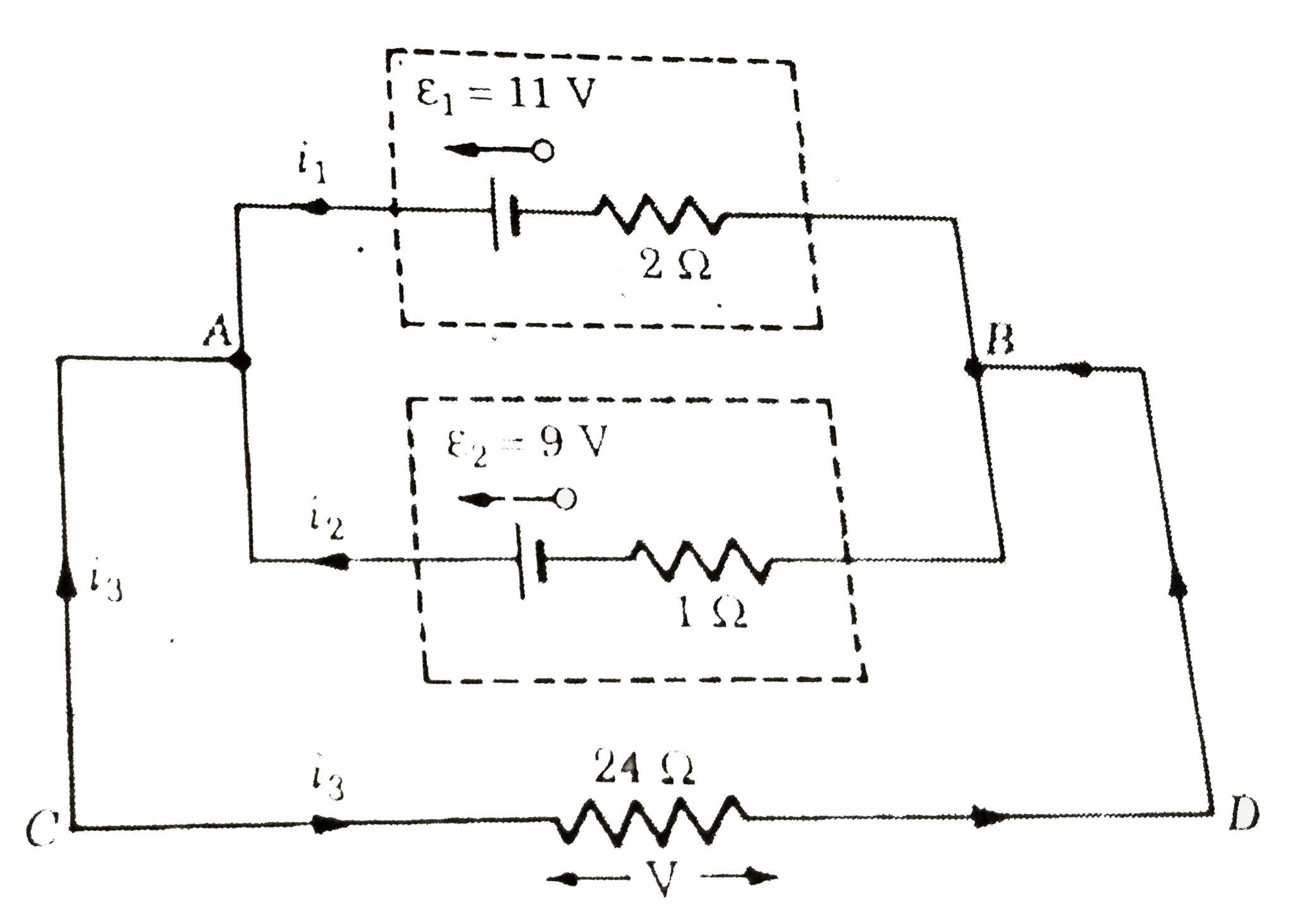
Compute the values of `i_(1),i_(2),i_(3) and V` in the circuit, shown in figure. The emf and the internal resistance of the upper cell are 11V and `2Omega`, and of the lower cell are 9 V and `1Omega.`
View SolutionA certain length of a uniform wire of resistance `12Omega` is bent into a circle and two points, a quarter of circumference apart, are connected to a battery of emf 4 V and internal resistance `1Omega`. Find the current in the different parts of the circuit.
View Solution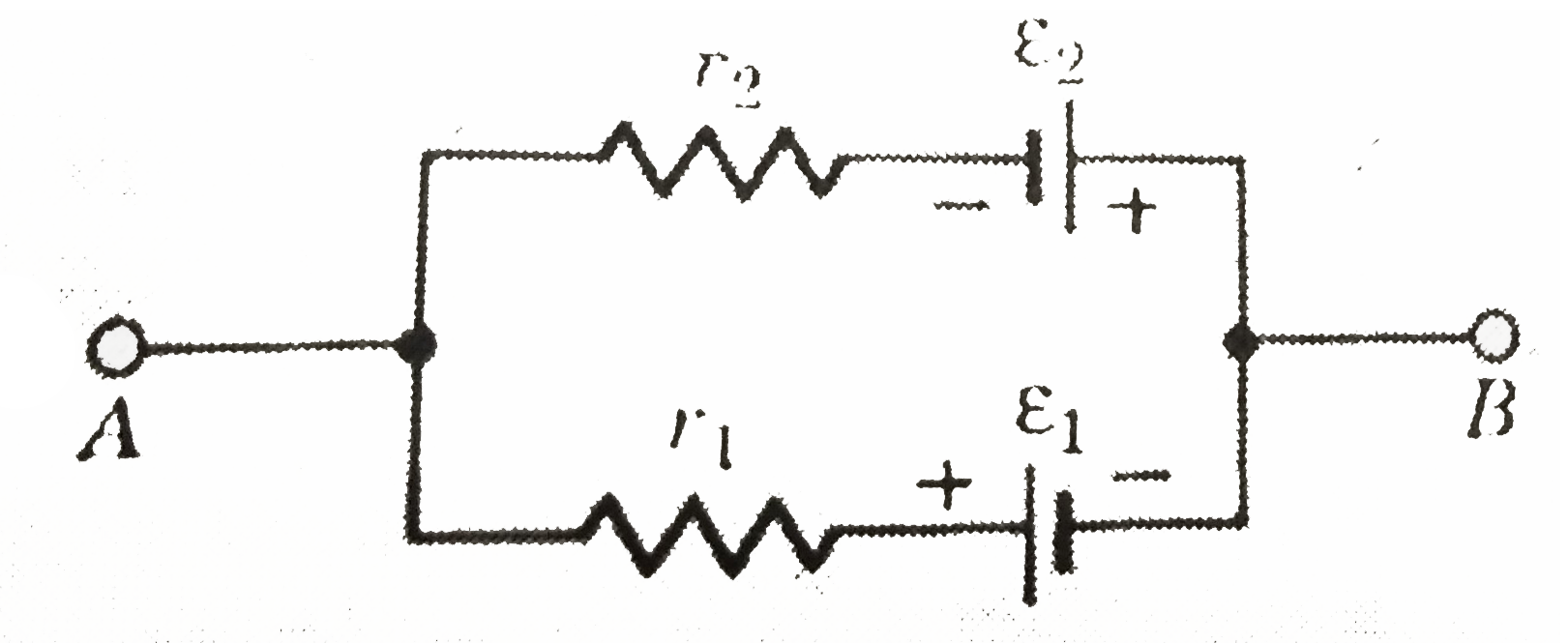
find the emf `(epsi_(0))` and internal resistance `(r_(0))` if a battery which is equivalent to a parallel combination of two batteries of emfs `epsi_(1) and epsi_(2)` and internal resistances `r_(1) and r_(2)` respectively, with polarities as shown in figure.
View Solution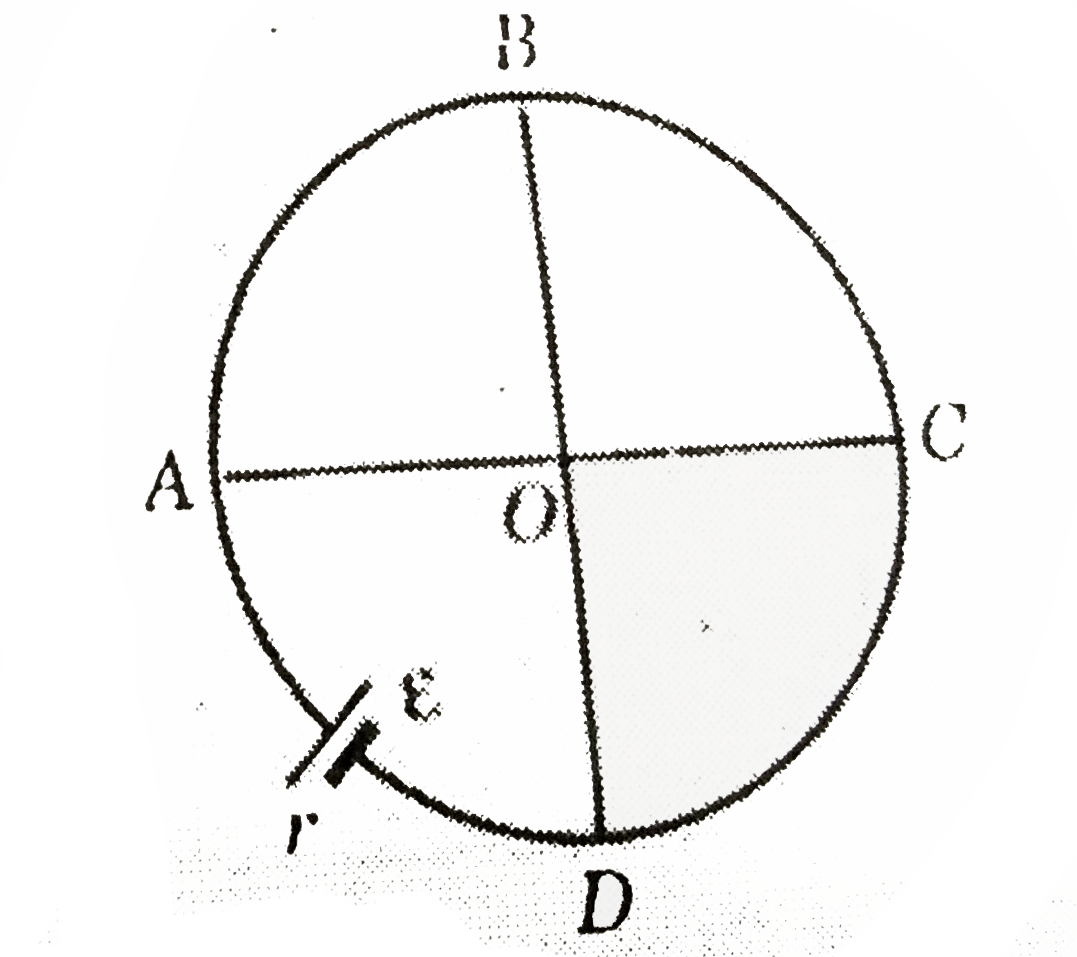
In figure. ABCDA is a uniform circular wire of resistance `2Omega,AOC` and BOD are two wires along two perpendicular diameters of the circle, each having ame resistance `1Omega`. A battery of emf `epsi` and internal resistance r is connected between the point A and D. Calculate the equivalent resistance of the network
View SolutionThree batteries of emf 4,5 and 6V and internal resistances 1,2 and `3Omega` respectively are connected in parallel with each other and the combination sends a current through an external resistance of `4Omega`. Find current drawn through each battery.
View SolutionOne ampere of current enters the junction A of a wheatstone bridge ABCD with `AB=2Omega,BC=2Omega,AC=4Omega,CD=2Omega and R_(g)=4Omega`. Find the current through the galvanometer.
View Solution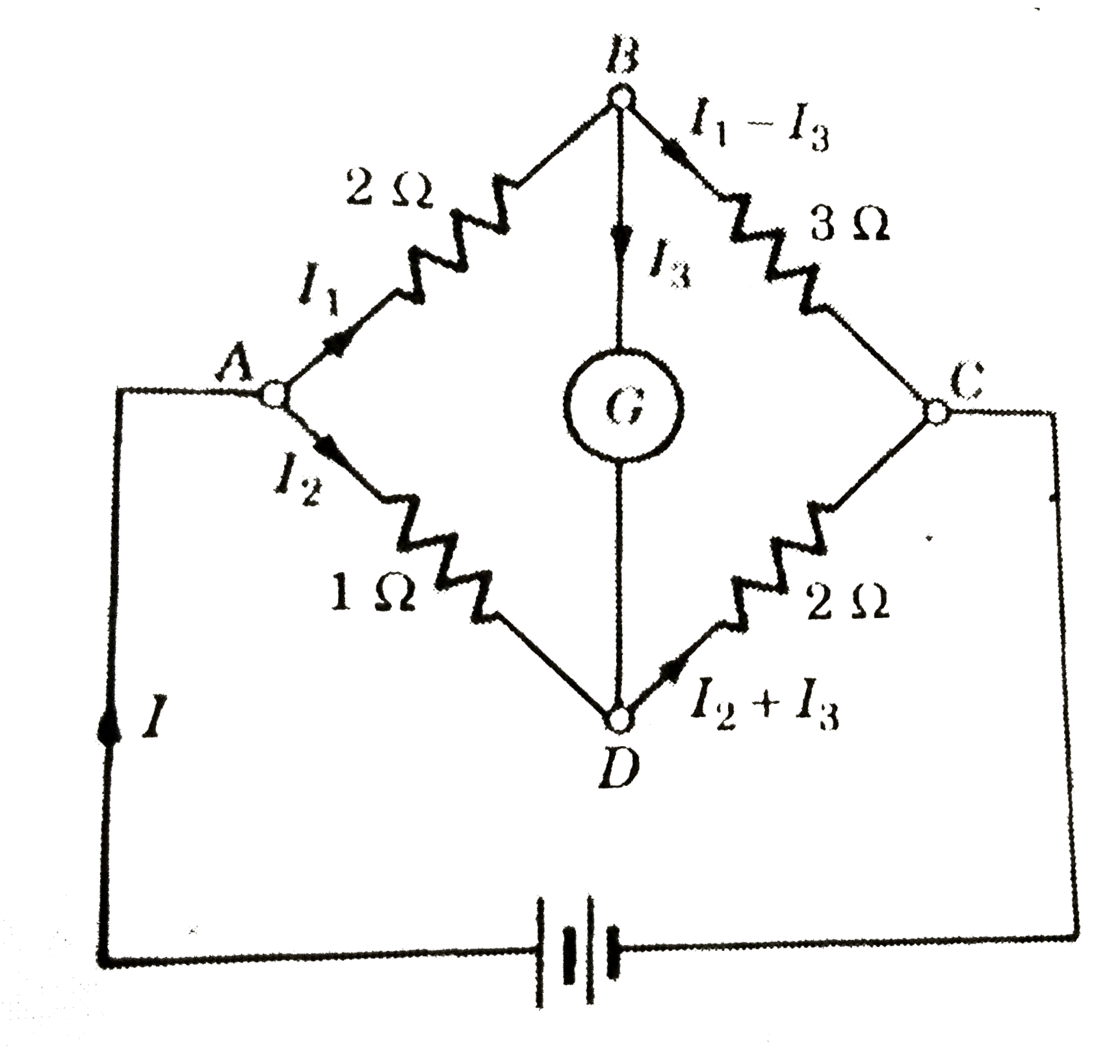
In the circuit shown in figure. Find the currents `I,I_(1),I_(2) and I_(3)` given that emf of th battery=2V, internal resistance of the battery `=2Omega` and resistance of the galvanomter `=4Omega`.
View SolutionDetermine the current flowing through the galvanometer G of the Wheatstone bridge shown in figure.
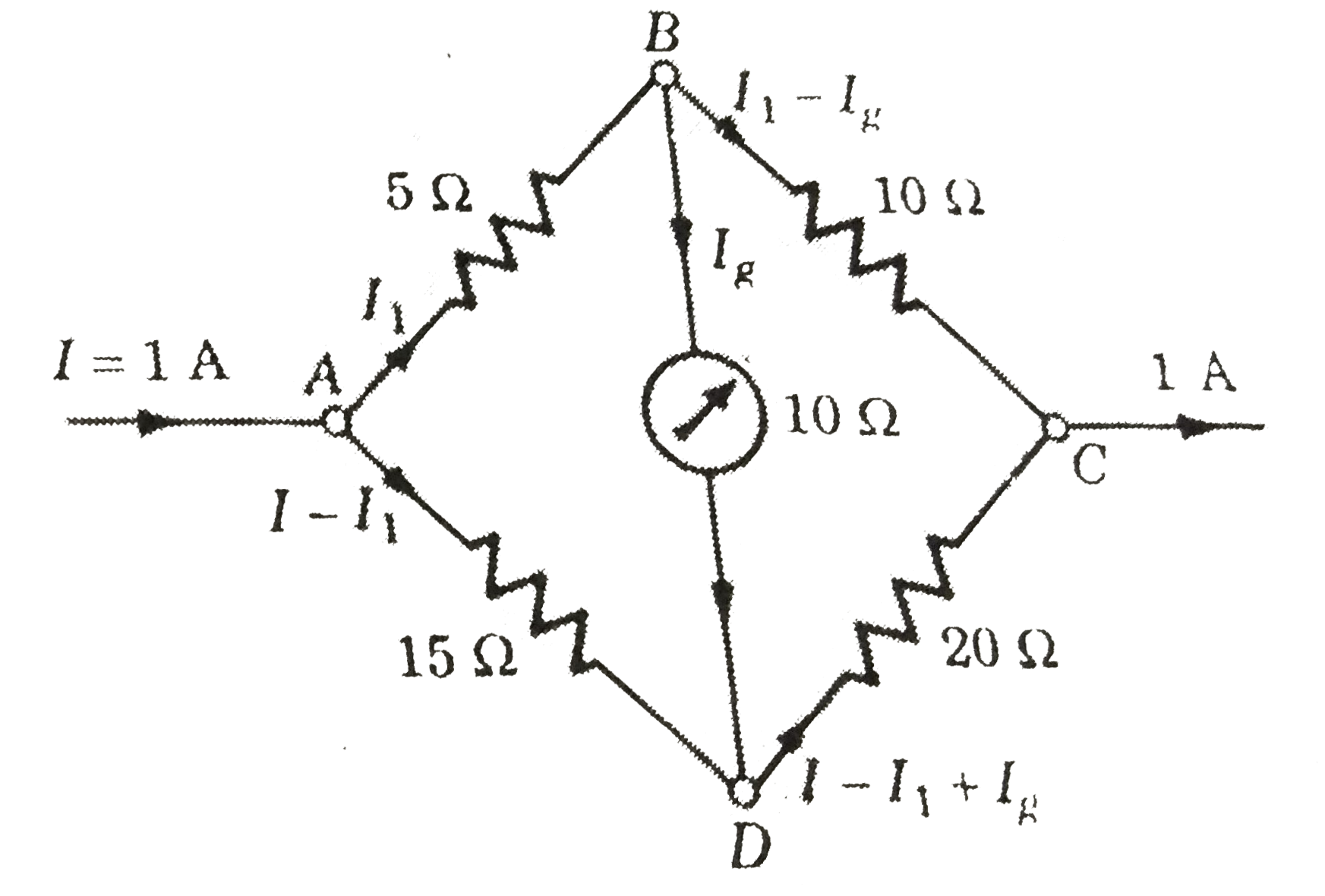 .
.
View SolutionA current of 0.1 A enters a Wheatstone bridge consisting of three arms of `10Omega` each and one of `11Omega`. What is the current in galvanometer f its resistance is 100?
View SolutionThe terminals of a battery of emf 3 V and internal resistance `2.5Omega` are joined to the diagonally opposite corners of a cubical skeleton frame of 12 wires, each of resistance `3Omega`. Find the current in the battery.
View SolutionTwelve identical wires each of resistance `6 Omega` are arranged to from a skelence cube. A current of `40 m A` is led cube at the current and out at the diagonally opposite corner. Calculate the potential difference development across these current and the effective resistance of the network
View SolutionTwelve equal wires each of resistance `r Omega` form a cube. The effective resistance between the corners of the same edge of the cube is
View SolutionA galvanometer has a resistance of `49Omega`.If `2%` of the main current is to be passed through the meter, The value of the shunt will be
View Solutionhow will you convert a 1mA full scale deflection meter of resistance `100Omega` into an ammeter to read into 1.0A?
View SolutionCalculate the value of resistance needed to convert a galvanometer of resistance `200Omega`, which gives a full scale deflection for a current of 5 mA, into a voltmeter of 0-10V range.
View SolutionA galvanometer with a coil of resistance `10.0Omega` shows full scale deflection for a current of 50mA. How will you convert the galvanometer into
(i). An ammeter of range 0 to 0.5 A and
(ii). A voltmeter of range 0 to 5V?
View SolutionA galvanometer has an internal resistance `1.0Omega`. It given maximum deflection for a current of 50 mA. Show how this instrument can be converted into (i) a voltmeter with a maximum reading of 2.5 V and (ii) an ammeter with a maximum reading of 2.5 A
View SolutionA galvanometer has a resistance of `15.0Omega` and the meter shows full scale deflection for a current of 2.0 mA. How will you convert this meter into (i) an ammeter of range 0-5.0A and (ii) a voltmeter of range 0 to 15.0V? Also determine the resistance of the meter in each case.
View SolutionIn galvanometer of resistance `20Omega` gives a deflection of one division when a potential difference of 4mV is applied across its terminals. Calculate the resistance of the shut if the current of 10A is to be measured by it. The galvanometer has 25 divisions.
View SolutionIn a galvanometer there is a deflection of one divisions per mA. The internal resistance of the galvanometer is `80Omega`. If a shunt of `2.5Omega` is connected to the galvanometer and there are 50 divisions in all, one the scale of the galvanometer, what maximum current can this galvanometer read?
View SolutionA galvanometer of resistanece `40Omega` gives a deflection of 5 divisions per mA. There are 50 divisions on the scale. Calculate the maximum current that can pass through it when a shunt resistance of `2Omega` is connected.
View SolutionIt is intended to measure a maximum current of 25 A with an ammeter of range 2.5 A and resistance `0.9Omega`. How will you do it? What will be the combined resistance?
View SolutionA galvanometer has a resistance of `30Omega` and a current of 2 mA is needed to give full scale deflection. What is the resistance needed and how is it to be connected to convert the galvanometer (i) into an ammeter of 0.3 A range and (ii) into a voltmeter of 0.2 V range?
View SolutionA galvanometer has a resistance of `100Omega`. A difference of potential of 1.0 V between its terminals gives a full scale deflection. Calculate the shunt resistance which will enable the instrument to read upto 2A.
View SolutionWhen a galvanometer having 20 divisions scale and `50Omega` resistance is connected in series to a cell of emf `1.5V` through a resistance of `100Omega`, its shows full scale deflection. Find the figure of merit of the galvanometer.
View SolutionA galvanometer has a sensitivity of 60 division/ampere. When a shunt is used its sentivity becomes 10 divisions/ampere. What is the value of shunt used if the resistance of the galvanometer is `20Omega`?
View SolutionA galvanometer of resistance `3663Omega` gives full scale deflection for a certain current `i_(g)`. Calculate the resistance of the shunt which when joined to the galvanometer coil will result in 1/34 of the total current passing through the galvanometer. also finid the total resistnace of the galvanometer and the shunt.
View SolutionA shunt of `6Omega` is connected across a galvanometer of resistance `294Omega`. Find the fraction of the total current passing through the galvanometer.
View SolutionA galvanometer is shunted by 1/n th of its resistance. Find the fraction of the total current passing through the galvanometer.
View SolutionIf a galvanometer is connected in series with a high resistance so that potential drop across the galvanometer is 1/n th of the total applied voltage, then show that the combined resistance of the galvanometer and the series resistor is n times the resistance of the galvanometer i.e.,
View SolutionA galvanometer has current sensitivity of 5 divisions/mA and a voltage sensitivity of 2 division/mV. If the instrument has 30 divisions, how will you use it to measure (i) a current of 3 A, and (ii) a voltage of 15V?
View SolutionA `250muA` meter has 50 divisions and it needs 250 mV for full scale deflection. How will you convert it to read (i) 05 mA/division and (ii) 0.5 V/division?
View SolutionIt is required to pass only one-tenth of the main current through a galvanometer having a resistanec of `27Omega`. Calculate the length of the wire of specific resistance `48xx10^(-6)Omegacm` and area of cross-section `0.2mm^(2)` required to make a shunt for this purpose.
View SolutionWith a potentiometer, null points were obtained at 140 cm and 180 cm with cells of emf 1.1 volt and one of unknown value respectively. Calculate the unknown emf.
View SolutionIn a method for comparing emfs by a potentiometer a balance point is found to be 50 cm with a Daniel cell of emf 1.1 volt. Where will you get the balance point with a Leclanche cell of emf 1.5 volt?
View SolutionIn a potentiometer with a cell of unknown emf the balance point was obtained at 60 cm and with a cell of emf 1.5 volt at 45 cm from the same end. Calculate the unknown e.m.f. of the cell.
View SolutionA potentiometer having a wire 10 m long stretched on it, is connected to accumulator havig a steady voltage. A leclanche cell gives a null point at 750 cm. if the length of the potentiometer wire is increased by 100 cm, find the new position of the null point.
View SolutionWith a certain cell, the balance point is obtained at 60 cm from the zero end of the potentiometer wire. With another cell whose emf differs from that of the first cell by 0.1 V, the balance point is obtained at 50 cm mark. Calculate the emf of the two cells.
View SolutionWith a cell of emf 1.5 V, the balance point is obtained at a distance of 60 cm from one end of the potential wire. Calculate the potential difference between two ends of the potentiomter wire if its total length is 100 cm.
View SolutionA 10 metre long potentiometer wire carries a steady current. A 1.018 volt standard cell is balanced at a length of 850 cm. find (i) the potential gradient along the wire and (ii) the maximum emf that can be measured.
View SolutionA potentiometer wire has a potential gradient of 0.0025 volt/cm along its length. Calculate the length of the wire at which null-point is obtained for a 1.025 volt standard cell. Also, find the emf of another cell for which the null-point is obtained at 860 cm length
View Solution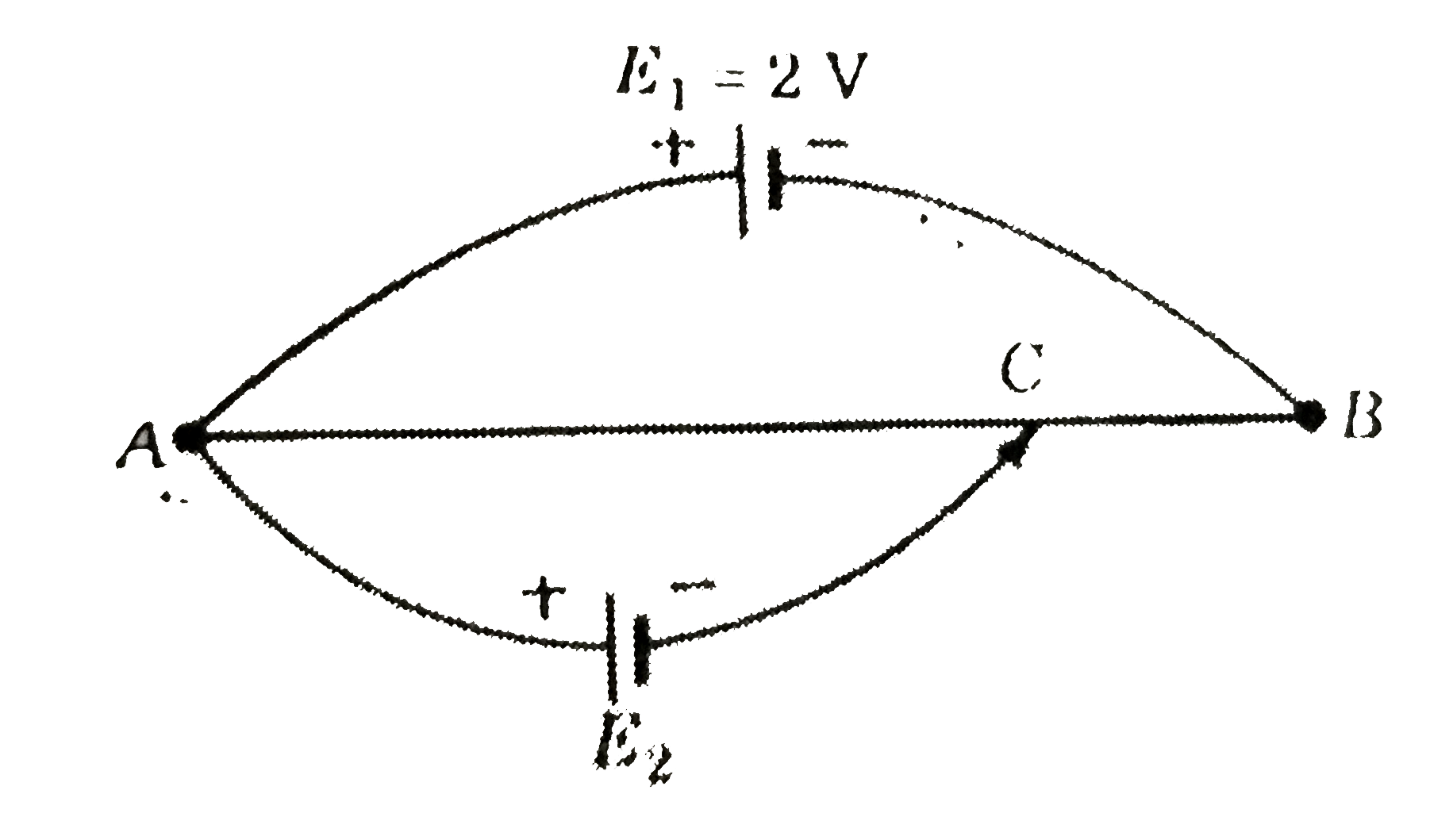
AB is a potentiometer wire of length 100 cm. when a cell `epsi_(2)` is connected across AC, where AC=75cm, no current flows from `epsi_(2)`. Find (i) the potential gradient along AB and (ii) emf of the cell `epsi_(2)`. the internal resistance of the cell `epsi_(1)` is negligible.
View SolutionA potentiometer is being used to determine the internal resistance of a primary cell. The balance point for the cell in an open circuit is at 76.3 cm. when the cell sends a current in a resistor of `9.5Omega`, the balance point shifts to 64.8cm. Find the internal resistance of the cell.
View SolutionA cell can be balanced against 110 cm and 100 cm of potentiometer wire respectively when in open circuit and shorted through a resistance of `10Omega`. Find the internal resistance of the cell.
View SolutionA potentiometer wire of length 100 cm has a resistance of `10Omega`. It is connected in series with a resistance and an accumulator of emf 2V and negligible internal resistance. A source of emf 10 mV is balanced against a length of 40 cm of the potentiometer wire. what is the value of the external resistance?
View SolutionThe resistance of a potentiometer wire is `18Omega`. A high resistance box and a 2 V accumulator are connected in series with it. What should be the value of the resistance in the box, if it is desired to have a potential drop of `1muV//mm`?
View SolutionA standard cell of emf 1.08 V is balanced by the potential difference across 91 cm of a meter long wire supplied by a cell of emf 2 V through a series resistor of resistance `2Omega`. The internal resistance of the cell is zero. Fnd the reistance per unit length of the potentiometer wire.
View SolutionIn an experiment with a potentiometer to measure the internal resistance of a cell, when the secondary circuit is shunted by `5Omega`, the null point is at 220 cm. when the cell is shunted by `20Omega`, the null point is at 300 cm. calculate the internal resistance of the cell.
View SolutionFour resistances of `15Omega,12Omega,4Omega and 10Omega` respectively are connected in cyclic order to form a wheatstone bridge. Is the network balanced? If not, calculate the resistance to be connected in parallel with the resistance of `10Omega` to balance the network
View SolutionFour coils resistances 3,6,9 and `30Omega` respectively are arranged to form a wheatstone bridge. Determine the value of the resistance with which the coil of `30Omega` should be shunted so as to balance the bridge.
View Solution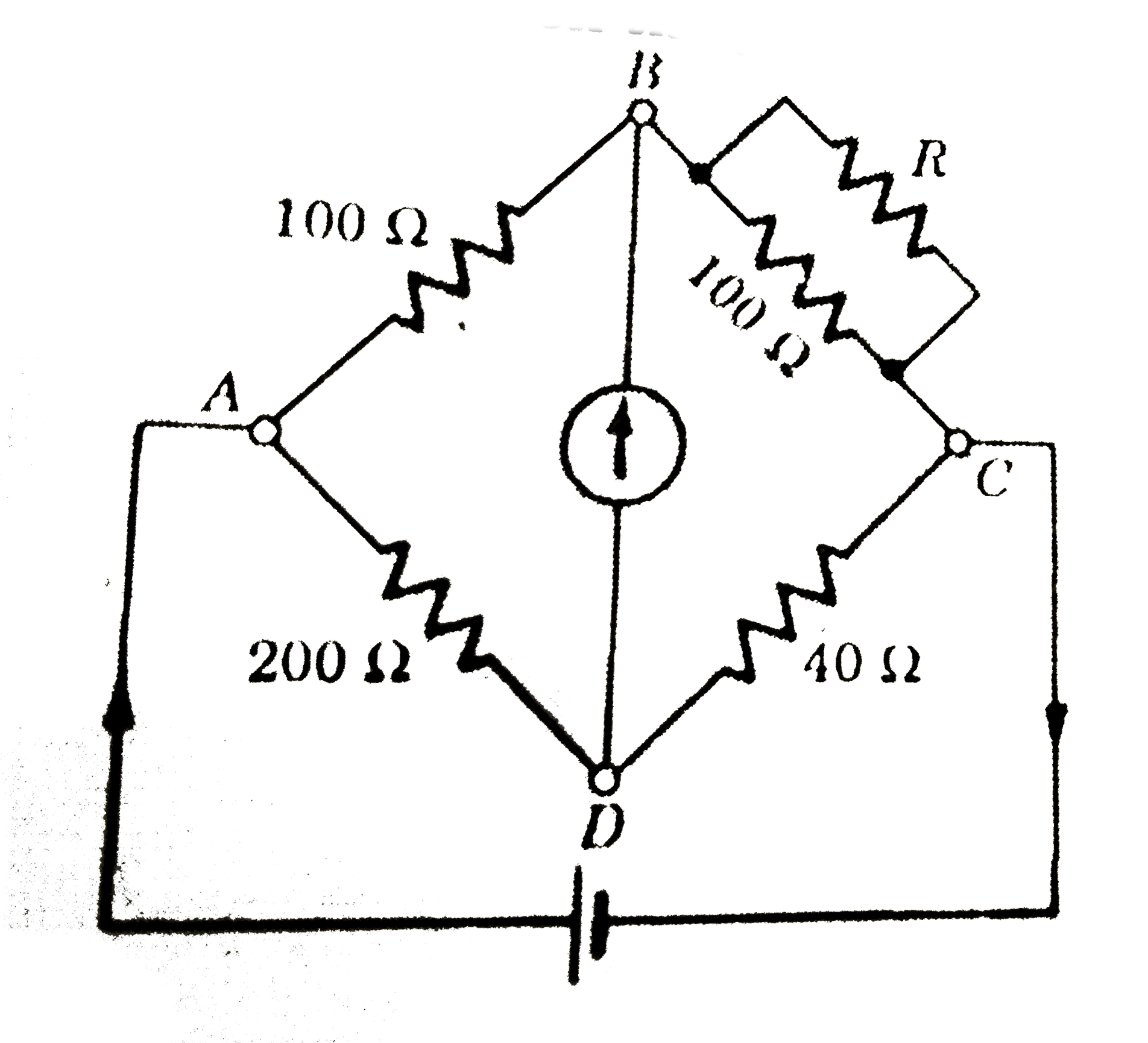
The wheatstone's bridge of figure. Is showing no deflection in the galvanometer joined between the points B and D. compute the value of R.
View Solution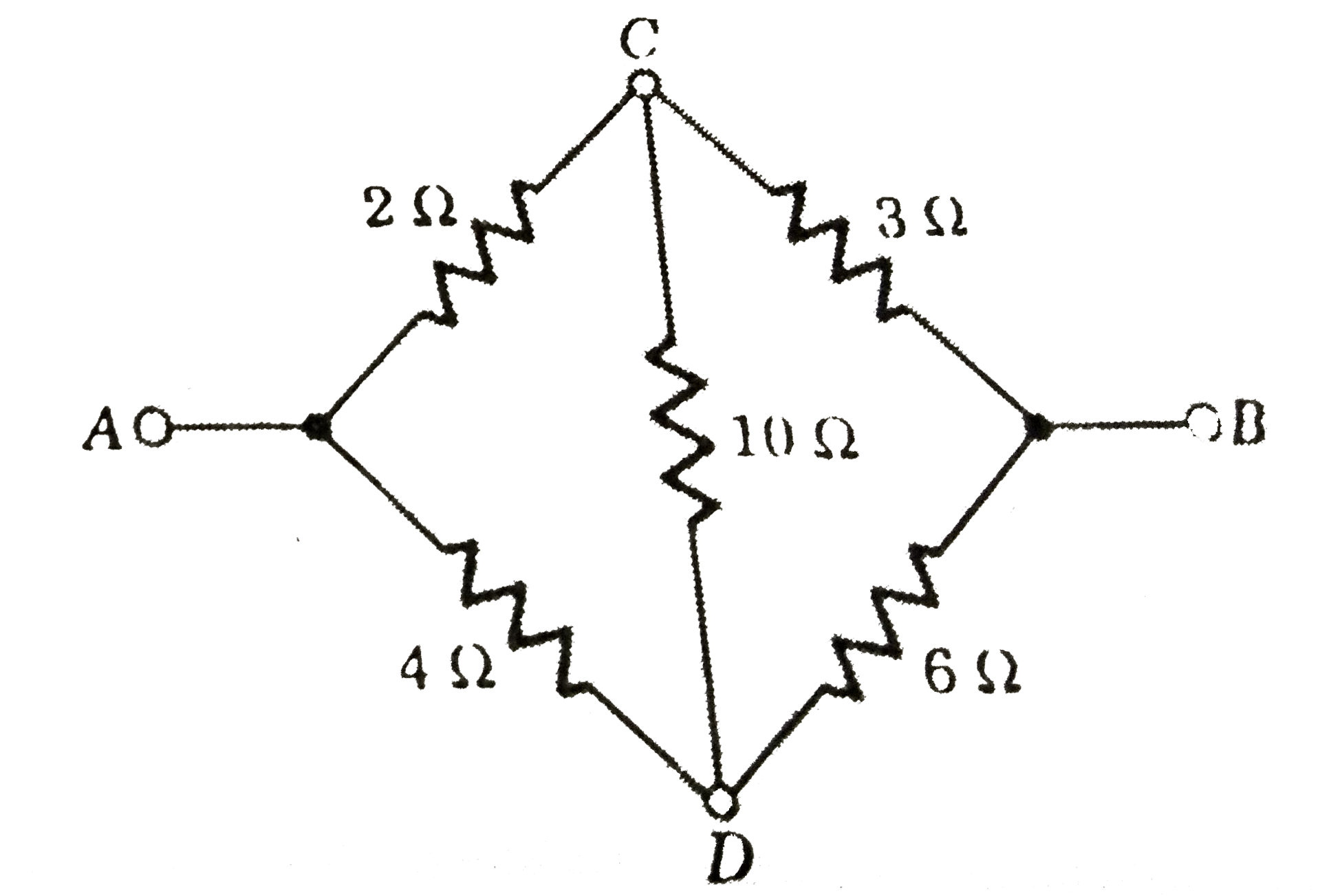
Five resistances are connected as shown in figure. What is the effective resistance between points A and B?
View Solution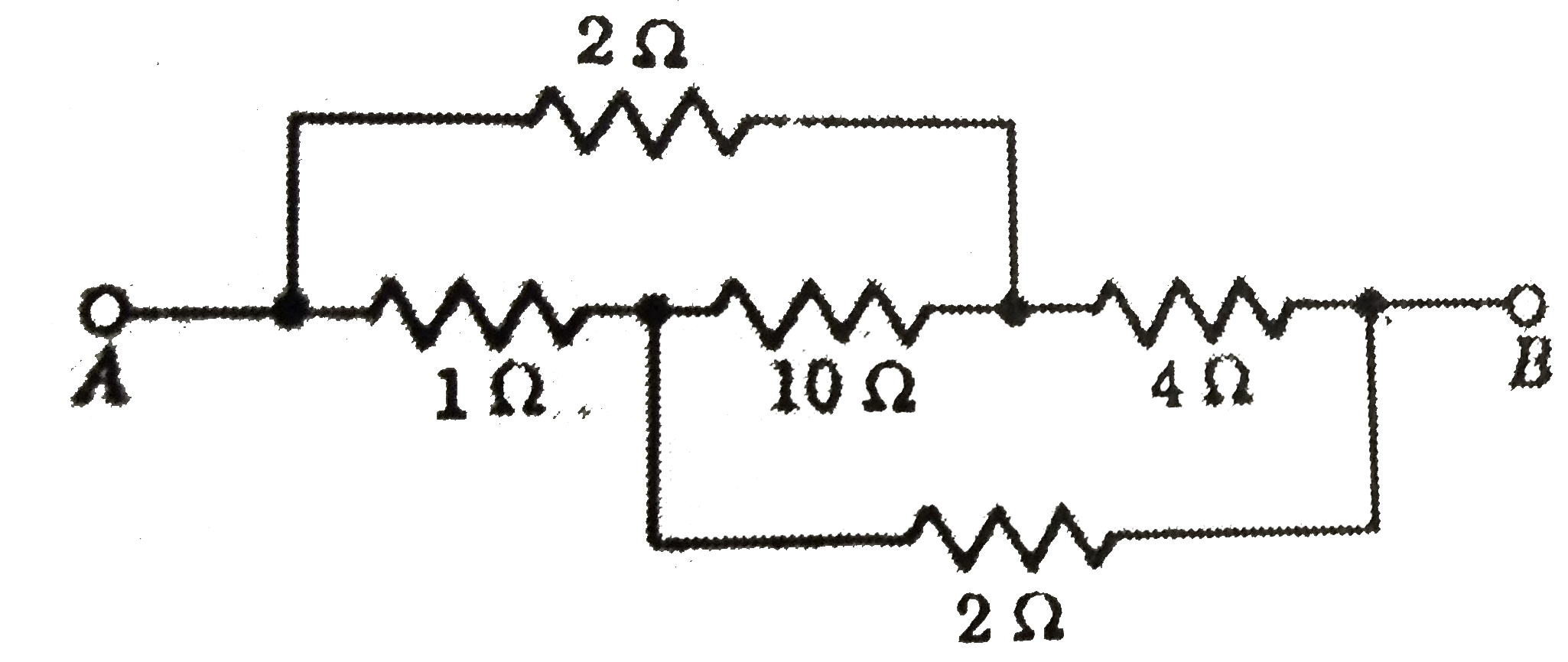
Calculate the equivalent resistance between points A and B of the network shown in figure.
View Solution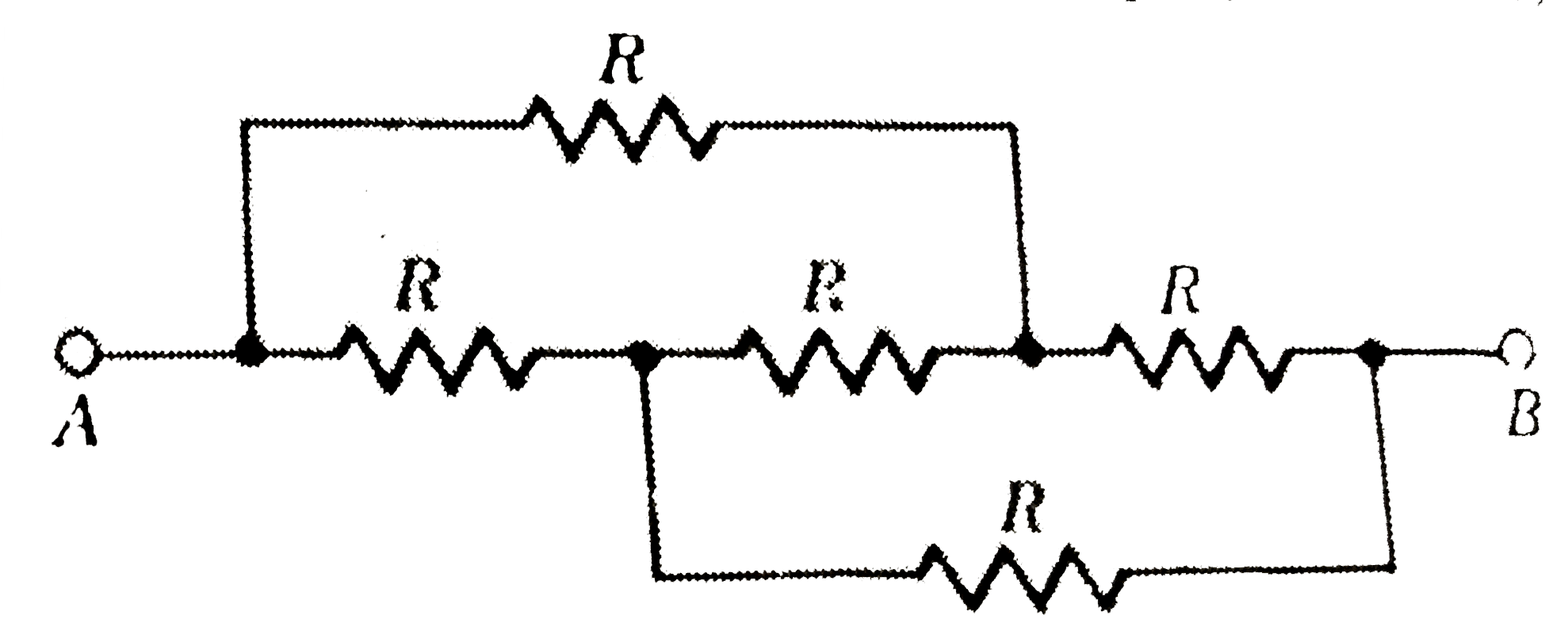
Calculate the equivalent resistance between the points A and B of the network shown in figure.
View Solution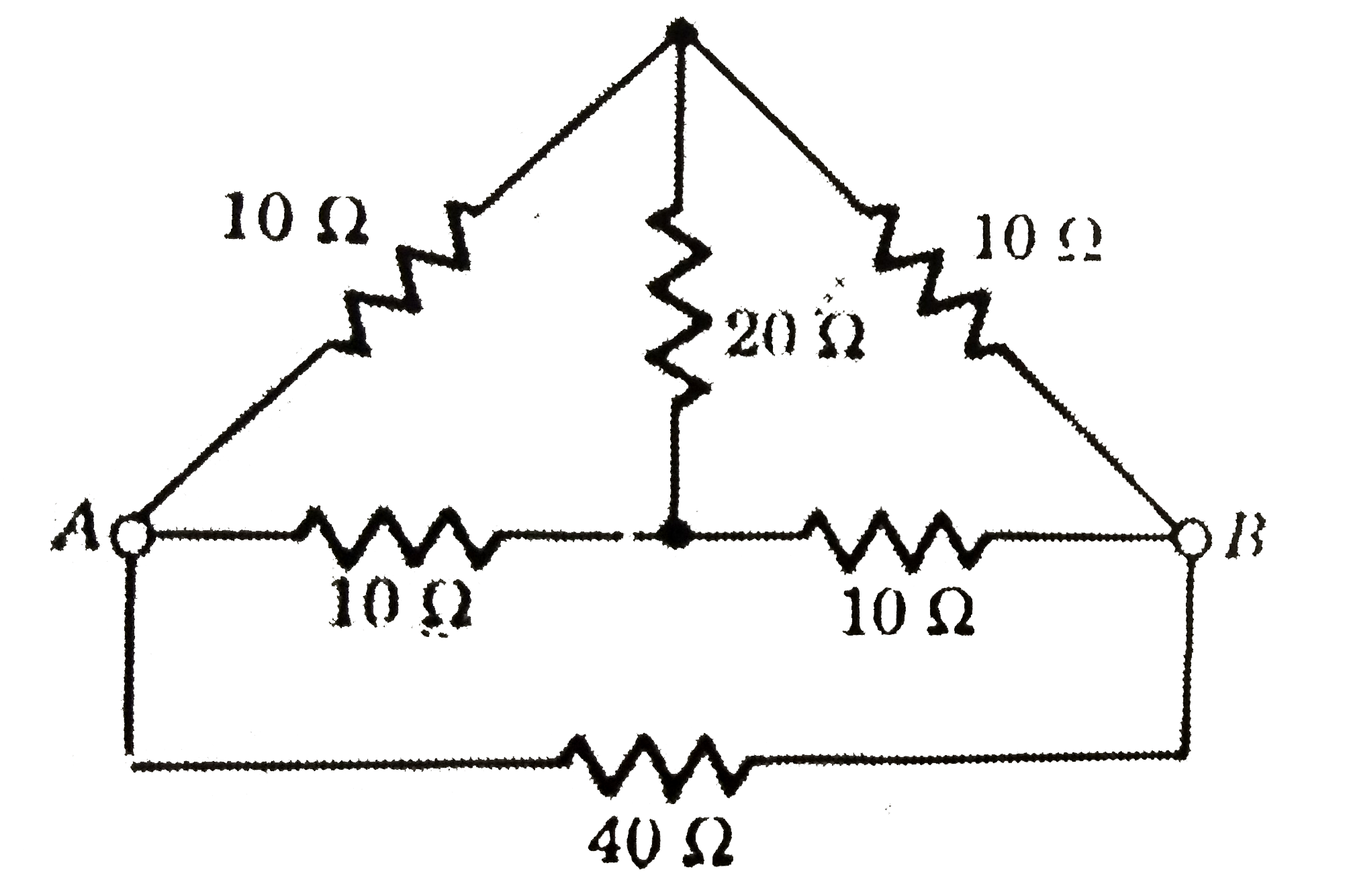
Calculate the resistance between the points A and B of the network shown in figure.
View Solution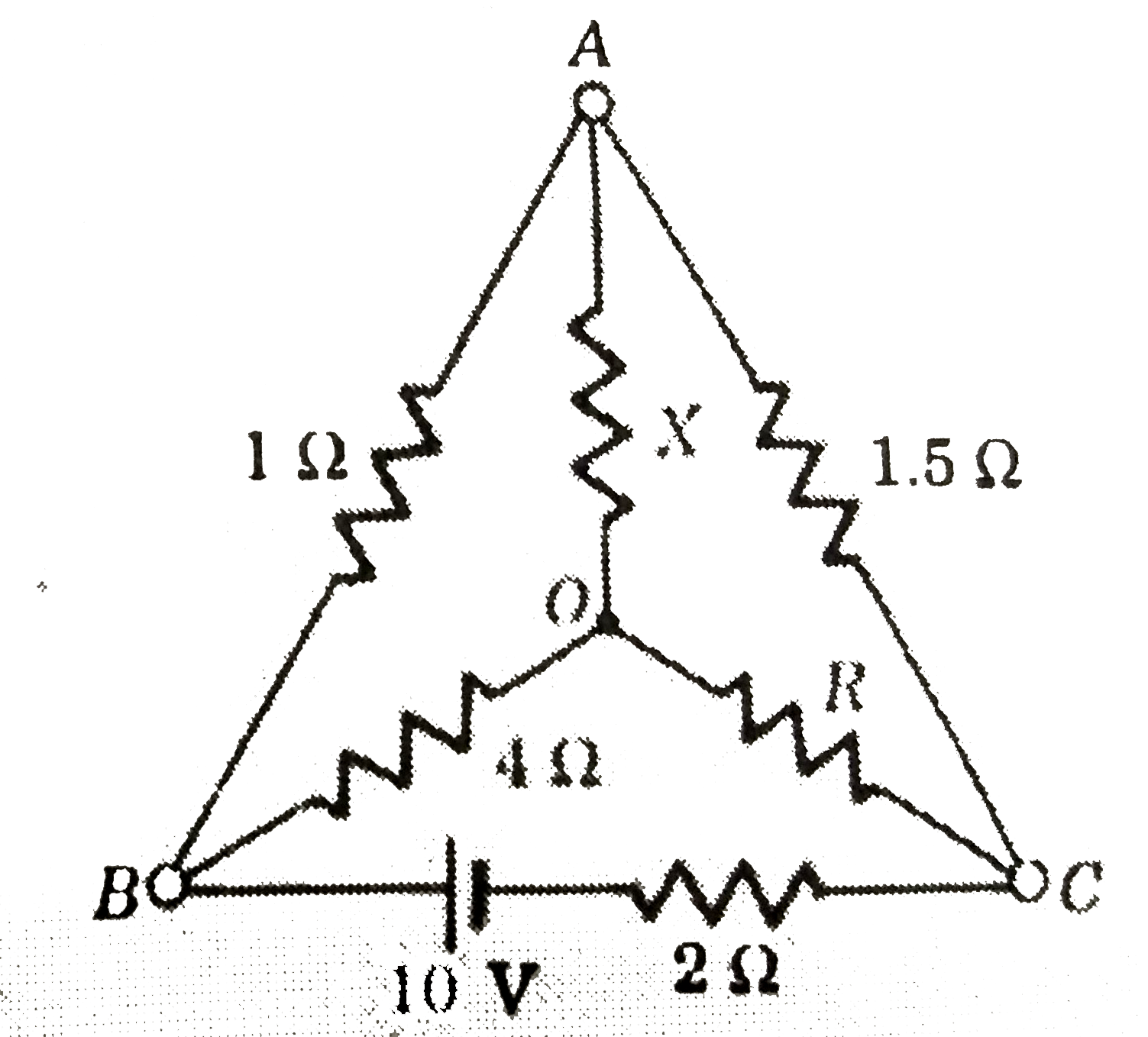
for the network shown in figure, determine the value of R and the current through it, if the current through the branch AO is zero.
View Solution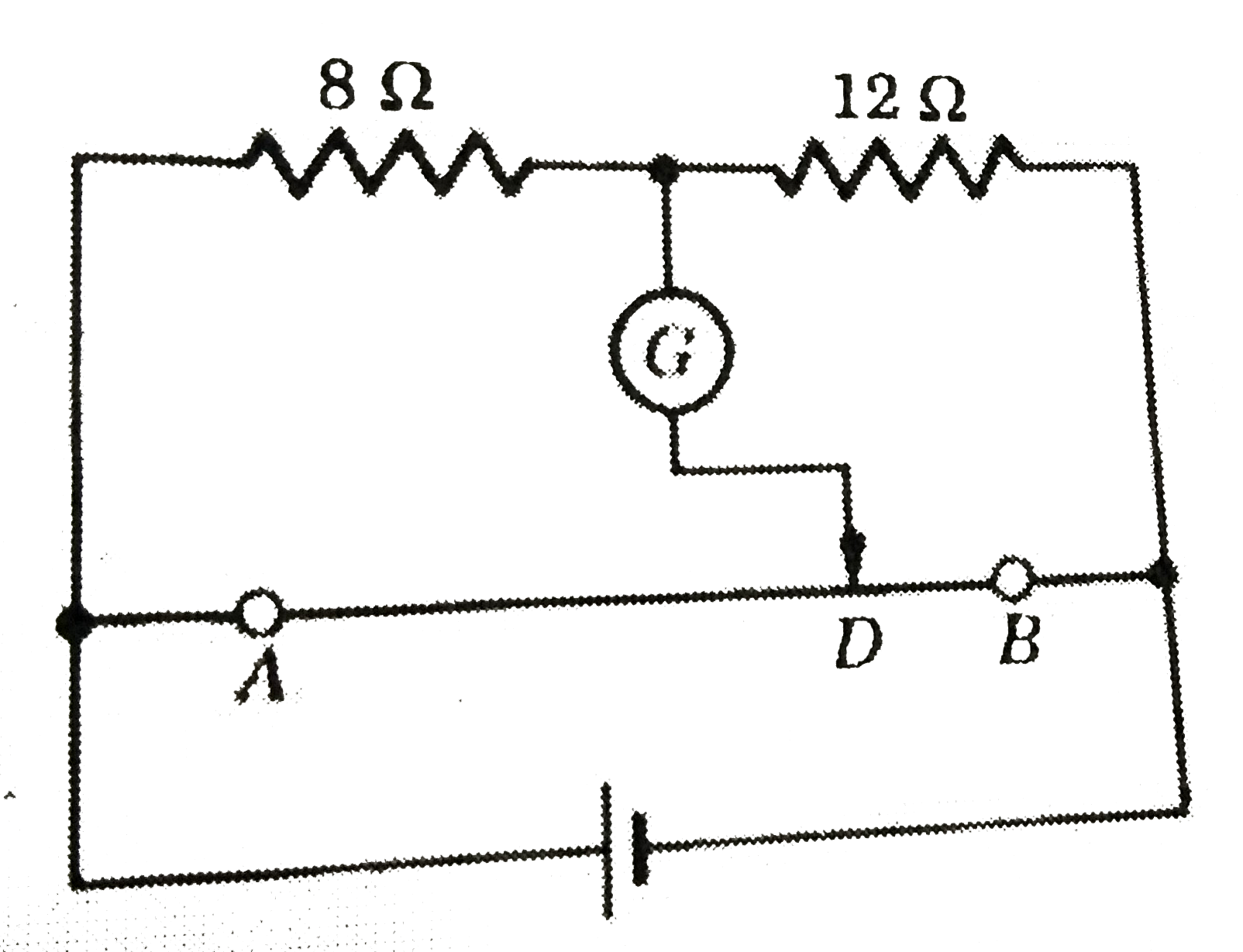
The potentiometer wire AB shown in figure. Is 40 cm long. Where should the free end of the galvanometer be connected on AB so that the galvanometer may show zero deflection?
View Solution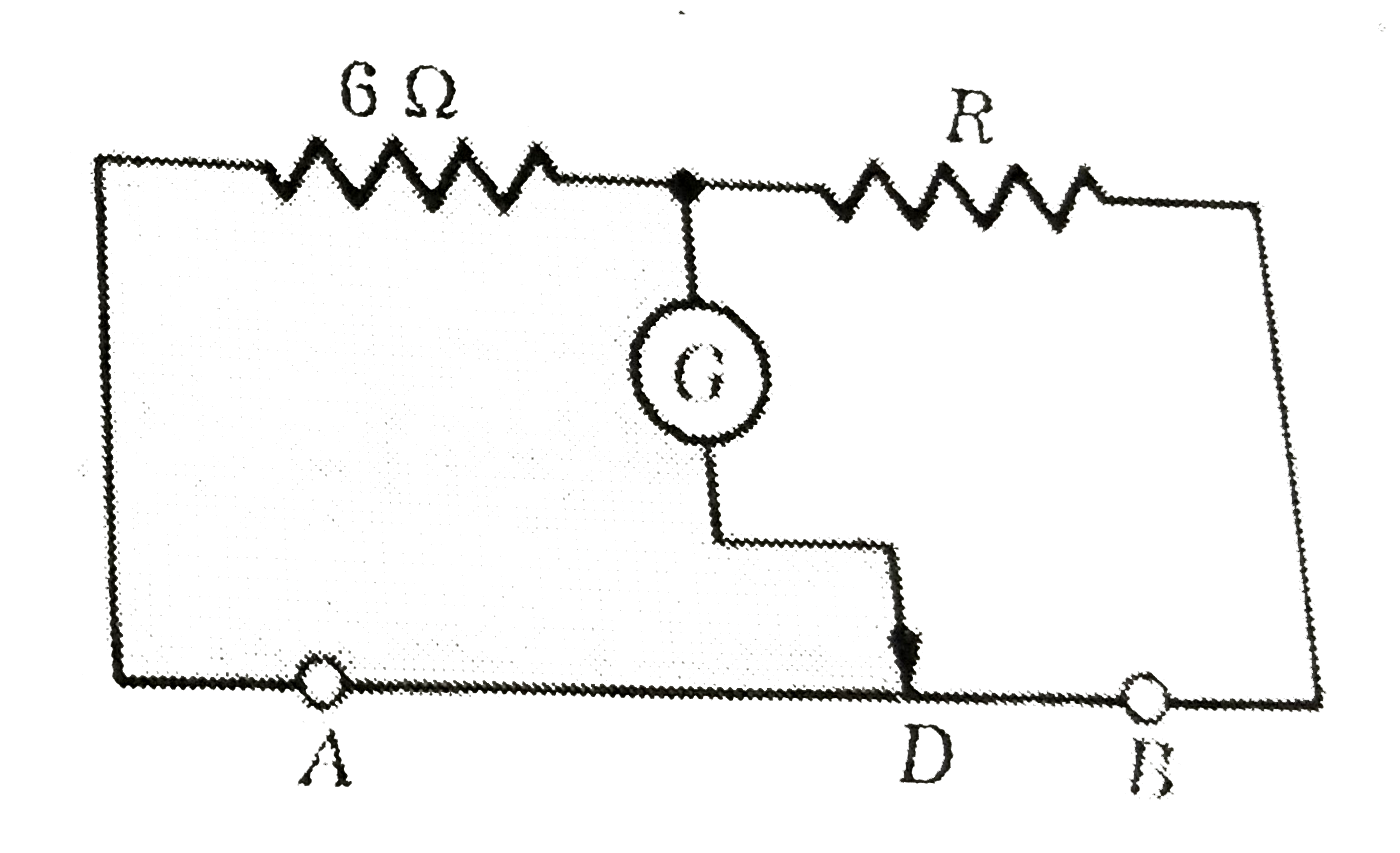
The potentiometer wire AB shown in figure. Is 50 cm long. When `AD=30cm`, no deflection occurs in the galvanometer. Find R
View SolutionIn an experiment with post office box, the ratio arms are `1000:10`. If the value of third resistance is `870Omega`, find the unknown resistance.
View SolutionP,Q,R and S are the resistances taken in the cyclic order in a wheatstone bridge network. P and Q are ratio coils, S is the unknown resistance and R is a `20Omega` coil. A balance is obtained when R is shunted with a resistance of `350Omega`. When P and Q are interchanged, the balance is restored by altering the shunt across R to `498Omega`. find the resistance of S and the ratio P:Q.
View SolutionA resistance of `5Omega` is connected in one gap of a metre bridge and `15Omega` in the other gap. Calculate the position of the balancing point.
View SolutionIn a metre bridge the length of the wire is 100 cm. At what point will the balance point be obtained if the two resistances are in the ratio of `4:5`.
View Solution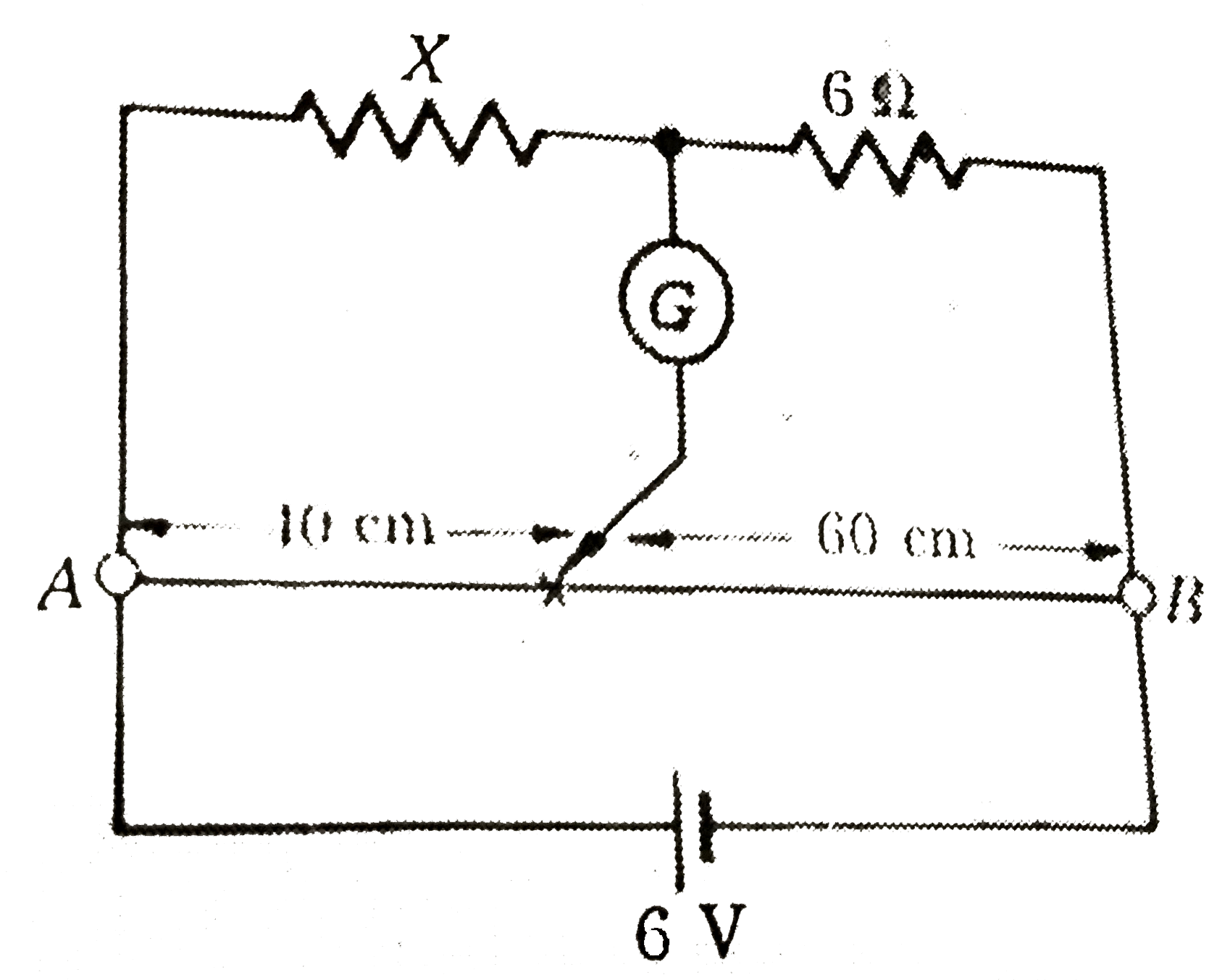
In the circuit shown in figure. A metre bridge is shown in its balanced state. The metre bridge wire has a resistance of a 4 ohm/cm. calculate the value of the unknown resistance X and the current drawn from the battery of negligible resistance.
View SolutionIn a metre bridge when the resistance in the left gap is `2Omega` and an unknown resistance in the right gap, the balance point is obtained at 40 cm from the zero end. On shunting the unknown resistance with `2Omega`, find the shift of the balance poiont on the bridge wire.
View SolutionIn comparing the resistance of two coils P and Q with the help of a metre-bridge arrangement, a balance point is obtained when the sliding contact is 50 cm from the zero end of the wire. The resistances P and Q are then interchanged and balance point is obtained at 120 cm from the zero end. Deduce the ratio of the resistances P and Q and the length of the wire.
View SolutionIn a meter-bridge experiment, two resistances P and Q are connected in series in the left gap. When the resistance in the right gap is `50Omega`, the balance point is at at the centre of the slide wire. If P and Q are connected in parallel in the left gap, the resistance in the right gap has to be changed to `120Omega` so as to obtain the balance point at the same position. find P and Q.
View SolutionIn a meter-bridge experiment with a resistance `R_(1)` in left gap and a resistance `X` in a right gap. null point is obtained at `40 cm` from the left emf. With a resistance `R_(2)` in the left gap, the null point is obtainned at `50 cm` from left hand. Find the position of the left gap is containing `R_(1)` and `R_(2)` (i) in series and (ii) in parallel.
View Solution
Problem for self practice questions and complete solutions for chapter ELECTRICAL INSTRUMENTS of DHANPAT RAI & CO PHYSICS (HINGLISH) of Class 12